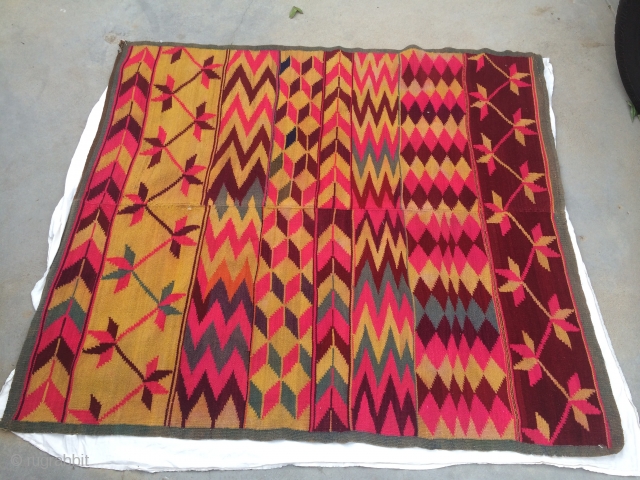What distinguishes them from other textiles are their colors, motifs and designs. Every one is quite different and unique. Probably because they were used exclusively in the royal robes of state for Inca queens and kings. Because they formed a spiritually important part of Inca ritual and culture, their survival remained precarious and doubtful during the Spanish conquest and colonial periods of Peruvian history. They come to us today only through an understanding of the Inca past memorialized by Spanish and indigenous chroniclers more than 400 years ago. The textile traditions found in Huamachuco are the only proven linkage to the textile traditions used by the Inca ruler and his queen. It is miraculous the tradition survived. Not one proven Inca elite textile exists today anywhere in the world.
The textiles are important. They are found in the permanent collections of the Smithsonian Institution, the Field Museum, the Philadelphia Museum of Art, the Gene Autry Museum of Western Heritage, and the Southwest Museum of the American Indian because of their quality, rarity, beauty and rich history. They have been acquired by textile connoisseurs and collectors and have appeared in prestigious publications including Architectural Digest and Hali magazines.
The story of their survival is important and really amazing: From the Spanish Inquisition and lost manuscripts, hidden text, and hieroglyphically written codes to the Napoleonic wars, the Duke of Wellington and Catholic monasteries, and later from book collectors, libraries and museums to academics from both the new and old worlds, the riddle of their survival and history is being unraveled and has never been better understood.
Most responsible for their survival are the indigenous Huamachuco from around the ancient Inca lands of Andamarca later becoming the Spanish land grant of the Hacienda Tulpo. With each generation over thousands of years, the weaving took on new meaning through different cultures that had come and gone dominating these lands. Each left a legacy of weaving deeply rooted in the past, but all these cultures converged during the time of the Inca who concentrated the finest weavers, spinners and dyers from all corners of the empire (Tawantinsuyo) on their rich grazing lands for large herds of alpaca, vicuña and huanaco.
During Inca times these lands belonged exclusively to the Inca rulers. Tapestry and plain weave cloth was manufactured into garments and bedding used by the Inca elite, especially the Inca queen. Huamachuco history is marked by changing ecologies that at one time extinguished and at other times ignited different traditions of weaving. The heritage their ancestors left for us today are the ornate elite textiles of the Inca past. The splendor of their weaving endured in spite of new awakenings that enveloped and modified their cultural landscape over the centuries. After the Spanish arrival, wool fibers replaced camelid fibers, natural and vegetal colored dyes became anilines, and the exclusive use of weaving manufactured for the Inca ruler and his queen became available to all the pueblo. The pueblo's isolation and the relegation of the indigenous population to the bottom stratum of the social hierarchy assured the weaving traditions survived.
Rug is sold as is, no returns. Please ask any and all questions prior to buying. i can send very specific photos at your request. Please anticipate shipping charges with carefully shipping a rug.
Thank you for looking.
- Home
- Antique Rugs by Region
- Category
- Profiles
- Post Items Free
- Albums
- Benaki Museum of Islamic Art
- Budapest: Ottoman Carpets
- Gulbenkian Museum
- Islamic Carpets. Brooklyn
- Islamic Textiles. Brooklyn
- Konya Museum: Rugs
- MKG, Hamburg
- MMA: Caucasian Carpets
- MMA: Mamluk Carpets
- MMA: Mughal Indian Carpets
- MMA: Ottoman Carpets
- MMA: Safavid Persian Carpets
- MMA: Turkmen Rugs
- McCoy Jones Kilims
- Ottoman textiles. Met
- Philadelphia Museum
- Rugs and Carpets: Berlin
- Seljuqs at the Met
- TIEM, Istanbul: Carpets
- V&A: Classical Carpets
- Vakiflar Carpets: Istanbul
- Baluch Rugs: Indianapolis
- Gallery Exhibitions
- Jaf an Exhibition
- Alberto Levi Gallery
- Andean Textile
- Christie's London: 2016
- Francesca Galloway
- HALI at 40
- ICOC Washington, DC 2018
- Jajims of the Shahsavan
- London Islamic Week April, 2018
- Mongolian Felts
- Navajo Rugs: JB Moore
- Persian Piled Weavings
- SF Tribal & Textile Art Show 2020
- SF Tribal 2019
- Sotheby's: C. Alexander
- Turkish Prayer Rugs
- Turkmen Main Carpets ICOC 2007












